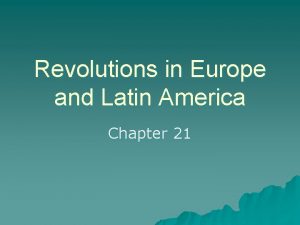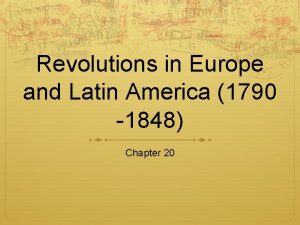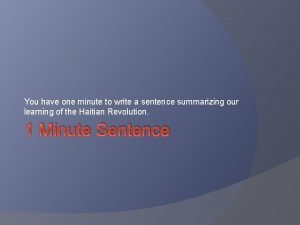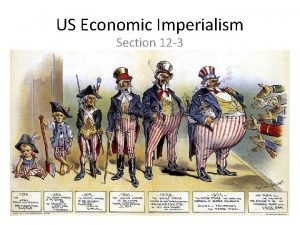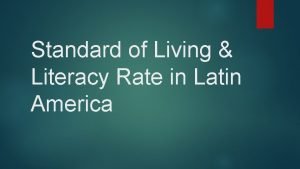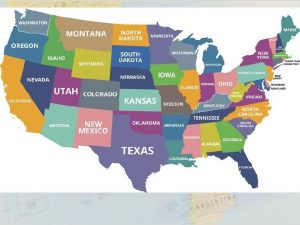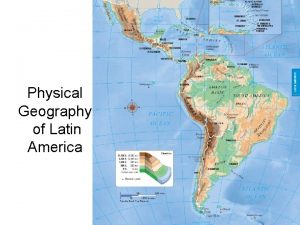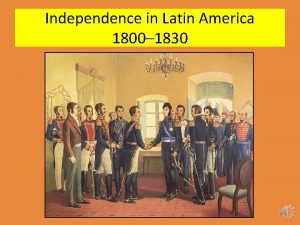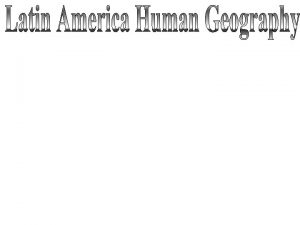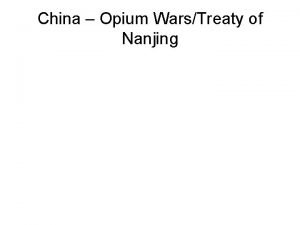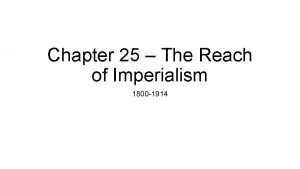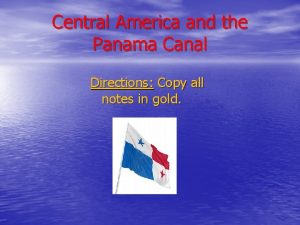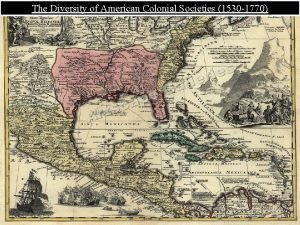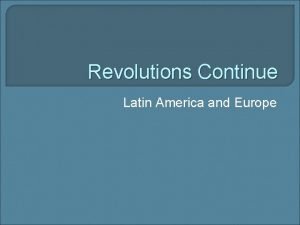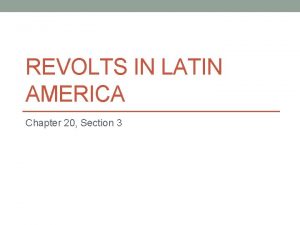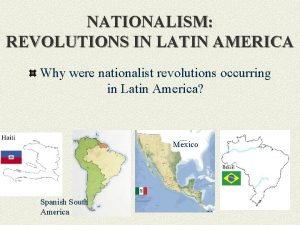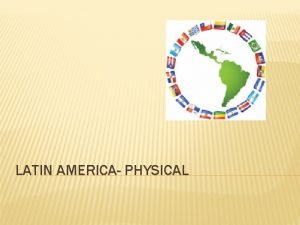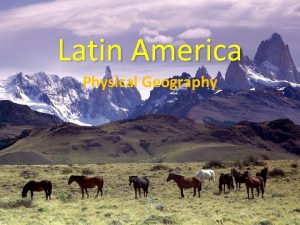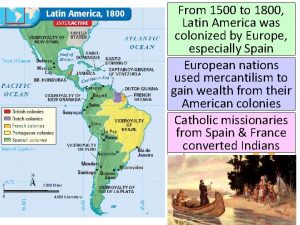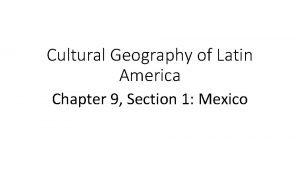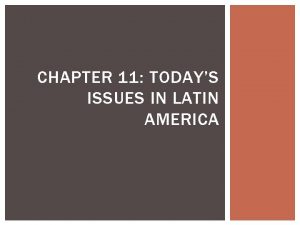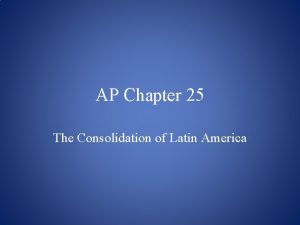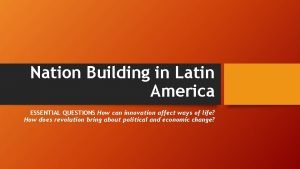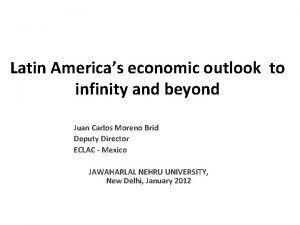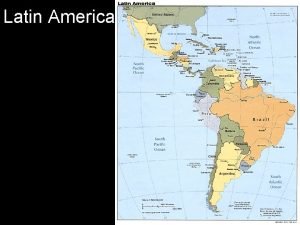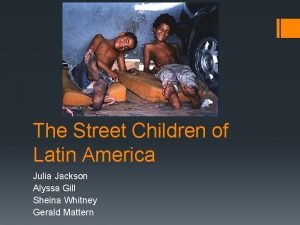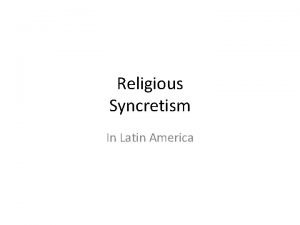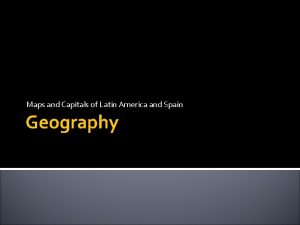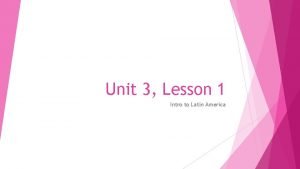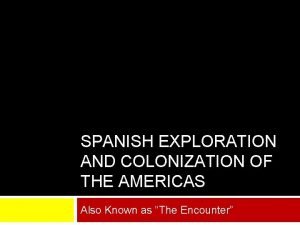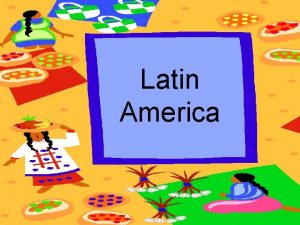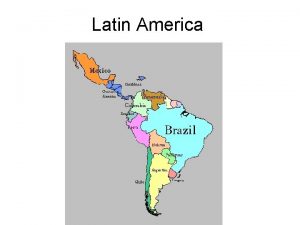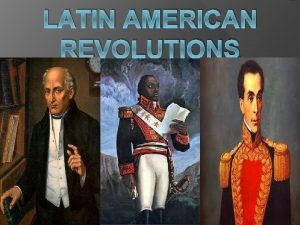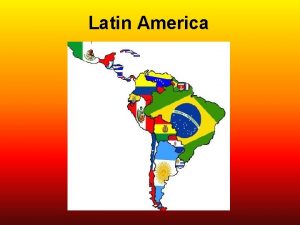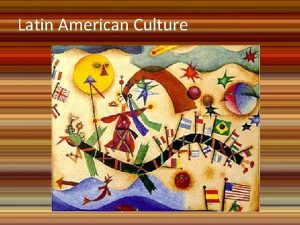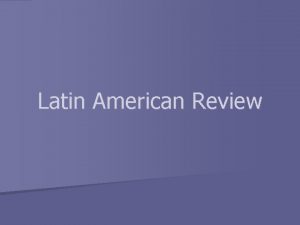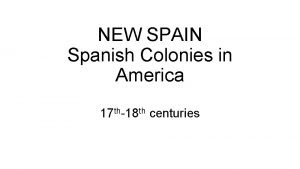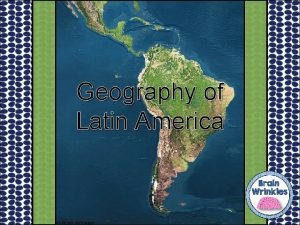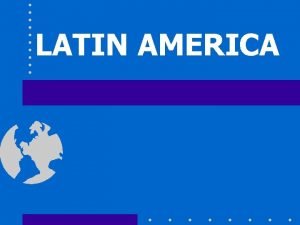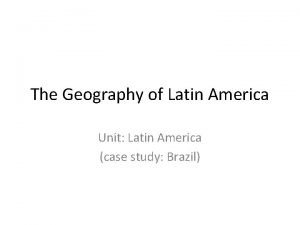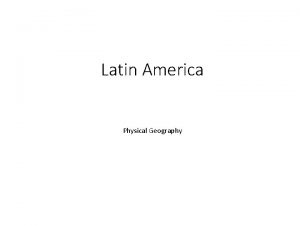Latin America New Ideas in Europe 16 th18











![Haitian Revolution 1791 -1804 • • Saint Domingue [renamed Haiti after revolution] Richest colony Haitian Revolution 1791 -1804 • • Saint Domingue [renamed Haiti after revolution] Richest colony](https://slidetodoc.com/presentation_image_h2/3fe655c20984a0ec87e3ceef0179b4e1/image-12.jpg)




![Vodoun [Voodoo] • A religious cult practiced chiefly in Caribbean countries (especially Haiti) • Vodoun [Voodoo] • A religious cult practiced chiefly in Caribbean countries (especially Haiti) •](https://slidetodoc.com/presentation_image_h2/3fe655c20984a0ec87e3ceef0179b4e1/image-17.jpg)
































- Slides: 49

Latin America


New Ideas in Europe 16 th-18 th centuries

Causes of Latin American Revolutions 1. Enlightenment Ideas • NATURAL LAWS govern natural science and human society. • Give people rights life, liberty, property! • Make fair societies based on reason possible. • Challenged theory of “Divine Right” monarchy.

2. Creole Discontent – Person of European descent born in the West Indies or Latin America – Left out of government jobs and trade concessions

3. Inspiration of American & French Revolutions Declaration of the Rights of Man & of the Citizen--1789 Declaration of Independence--1776

4. Preoccupation of Spain & Portugal 5. In Fighting Napoleonic Wars

Napoleon on the March Provides a model & a diversion!

Napoleon’s Role • Attacked Portugal and Spain • Toppled their rulers • Weakened their control of the Colonies – Spanish king is imprisoned by Napoleon in 1808 Revolts led by the Creole elite-landowners

Latin American Revolutions!

Question of Slavery • In France Friends of Blacks club advocated abolition of slavery • Abolished in France September 1791 • Opposed by French plantation owners in West Indies • National Convention February 4, 1794 abolishes slavery in colonies
![Haitian Revolution 1791 1804 Saint Domingue renamed Haiti after revolution Richest colony Haitian Revolution 1791 -1804 • • Saint Domingue [renamed Haiti after revolution] Richest colony](https://slidetodoc.com/presentation_image_h2/3fe655c20984a0ec87e3ceef0179b4e1/image-12.jpg)
Haitian Revolution 1791 -1804 • • Saint Domingue [renamed Haiti after revolution] Richest colony in world 8000 sugar and coffee plantations Population – 500, 000 slaves – 40, 000 whites – 30, 000 free people of color • Revolution seen differently by different groups – Rich white landowners saw greater autonomy and less economic restrictions – Poor whites sought equality for all whites – Free people of color wanted equal treatment for all [opposed by both white groups] – Slaves saw promise of freedom

Toussaint L’Ouverture 1791 • Leader of revolt with over 100, 000 followers • 1794 Robespierre ended slavery • 1799 Napoleon changed policy • After 10 years he gained control of island, issued constitution and became the effective ruler of Saint Domingue • Napoleon sends Le. Clerc who captures L’Ouverture, chains him and takes him to France 1000’s of French died with Yellow Fever • Civil War among factions after independence declared in 1804 • 1820 Independent Republic

Independence declared in Haiti (1804) Former French Sugar Colony the first Independent State in Latin America

Louisiana Purchase • Treaty of Paris in 1763 gave Spain control of the former French territory of Louisiana • 1800 France and Spain had a secret treaty giving this land to France but it remained under Spanish control until 1803. • Napoleon had hoped to rebuild France’s New World Empire but the defeat in Haiti and war with Britain persuaded him to sell the entire territory just three weeks after gaining control from Spain • Jefferson purchased the territory with much opposition.

![Vodoun Voodoo A religious cult practiced chiefly in Caribbean countries especially Haiti Vodoun [Voodoo] • A religious cult practiced chiefly in Caribbean countries (especially Haiti) •](https://slidetodoc.com/presentation_image_h2/3fe655c20984a0ec87e3ceef0179b4e1/image-17.jpg)
Vodoun [Voodoo] • A religious cult practiced chiefly in Caribbean countries (especially Haiti) • Involves witchcraft and animistic deities

Who’s POV? Slave Revolt

Question of Slavery • Britain abolishes slave trade in the British Empire in 1807 fearing slave revolts • US prohibits trade with Haiti and ends international slave trade in 1808 • Slavery itself is abolished in Britain in 1833 and in the US in 1863

Changes in Thinking Helps to End Slavery • Slave population outnumbers slave owners= fear of revolt • Immoral =un-Christian • Philosophes= Against Natural Law • Adam Smith= inhibits economic growth

Consequences for the end of slavery Workers imported from China and India became indentured servants willing to give up freedom in return for employment

Latin America • Unlike the American colonies of Britain the Latin colonies had little tradition of local self-government • They were more authoritarian • More divided socially • Their culture was formed by strict Catholicism of the Counter-Reformation • The Europeans were vastly outnumbered by native peoples, those of African ancestry, or those of mixed race • 1808 -Napoleon invade Spain and Portugal deposing Spanish king and forcing Portuguese royal family into exile in Brazil

Compare American Revolution to Latin Americans • • American Violence directed almost entirely vs. Britain Those who sided with Britain were later able to re-enter US society United States Began as a lesser colony but emerged as powerful and influential • • • Latin America Lasted twice as long Divided by class, race, and region Dread of social rebellion from below Inability to unite South America Began as the wealthiest but later became impoverished

Spain and Portugal Suppress Revolts • Aided by Creoles and Mazombos [American born direct descendants of Portuguese settlers] • Saw themselves linked more closely with Spain and Portugal’s rulers • Feared rebellion more than their desire for independence

1810 Mexico Revolts Leaders • Father Miguel Hidalgo • Father Jose Morales– a mestizo [mixed ancestry] Parish priest led peasant rebellion who desired more land • • Morales’ Goals displace Spanish and Creole elites abolish slavery revoke special privileges of church he was captured and shot

Mexico’s Path • Crushed by Creole landowners with support of RCC • 1821 independence gained with alliance of clergy and Creole elites • 1823 Republic declared • Unstable for decades • 1836 Mexican American War— – Texas declares independence Unlike other independence movements in Latin America because it was led by Mestizos and Native Americans not wealthy, educated Creoles

Mexico continued • First rebellions demanded reforms • Lack of support from creoles for insurrection= collapse • After years of turmoil under the republic little changed for the Mestizos or Native Americans • French occupation • Benito Juarez institutes reforms in 1860’s

Brazil • When Napoleon captured Portugal the royal family escaped to Brazil establishing their rule for the next 13 years. • King Dom Joao raised legal status of Brazilians to that of Portuguese • Expanded Rio de Janeiro as center of trade, administration, education and culture • Independence 1822 with help of Prince Pedro who acted as regent and became a constitutional emperor

Simon Bolivar • Venezuela • Wealthy Creole officer • Educated in Europe with enlightenment ideas • Joined a growing class of merchants who resented Spanish and Portuguese domination of trade • United into new nation—Gran Columbia [Columbia, Ecuador, Venezuela]

Bolivar coming from the North. The “Muscle” of the Revolution José de St. Martín and Bernard O’Higgins cross the Andes Mountains.


Bolivar’s Accomplishment

Bolivar’s Failure Ø After uniting Venezuela, Columbia, & Ecuador into Gran Columbia, he left to help free the rest of Latin America. Ø He died a year later, with his goal of uniting all of South America unfulfilled!


Results of the Revolutions

1. Brazil Freed from Portugal Ø The Portuguese royal family escaped Napoleon by fleeing to Brazil. Ø Pedro I set up a new, independent kingdom in 1821 when his father returned to Portugal. Ø Pedro II assumed full power after Pedro I abdicated his throne.

2. Independence for Spanish & Portuguese Latin America Ø By the mid-1820 s, revolts create many newly-independent nations.

3. No Unity! Ø Failure of Bolivar’s dream for a united South America: Ø Many newly independent countries struggle with civil wars. Ø By 1830 s’ defeated attempts at unification. Ø geographic factors—mountain, the Amazon, etc. Ø cultural differences

4. Independence Brought More Poverty Ø Wars disrupted trade. Ø Wars devastated cities and countryside.

5. Left Many Countries in the Control of Caudillos Ø WHO WERE THEY? : Ø Mid-19 c dictators military authoritarianism. Ø Mostly wealthy Creole aristocrats. Ø Posed as reformers with goals to improve the economy and better the lives of the common people. BUT…Overthrew governments and took away basic human rights. Ø Some attempted to make improvements, but most just cared about themselves and their families and friends [nepotism]. Ø Power changes usually occurred at bayonet-point [coup d’etats!]

What is the Message?

Additional Problems Ø Feuds among leaders. Ø Geographic barriers. Ø The social hierarchy continued from the past. Ø Conservatives favored the old social order. Ø Liberals wanted land reform. Ø Dependence on foreign nations for capital and for economic investments.

The Caribbean: an “American Lake”

“The Colossus of the North” Ø Ø Ø US dominated affairs in the Americas. 1823 – Monroe Doctrine. US takes Texas US gains independence for Cuba. US built Panama Canal – “Yankee Imperialism. ”

The Panama Canal

Causes of the Mexican Revolution of 1910? 1. Long dictatorship of Porfirio Diaz 18761910 2. Unequal distribution of wealth 3. Liberal reformers

Mexican Revolutionaries Porfirio Diaz Faced with rebellion he resigns after holding power for almost 30 years Madero, a liberal reformer, democratically elected in 1911, assassinated two years later by his general, Huerto

Carranza, a rich landowner, defeats Zapata and Villa, becomes president of Mexico in 1917. A new constitution passes but reforms are slow Huerto sets up dictatorship Civil War Rebel leaders, Zapata and Villa, fight to improve lives of peasants Zapata Pancho Villa Carranza

Post Revolution Latin America • Loss of population, property, livestock because of war • Boundary disputes with other new nations • Poor transportation and communication making unity within nation difficult • Little experience ruling as a republic • Britain replaced Spain and Portugal as dominating the economy • Exportation of raw materials while importing finished goods reducing industrial production in Latin America leading to more foreign domination of their economy • Land remained basis of wealth, social prestige, political power throughout 19 th century
 Why is it called latin america
Why is it called latin america America vs africa
America vs africa Revolutions in europe and latin america section 2 quiz
Revolutions in europe and latin america section 2 quiz Revolutions in europe and latin america
Revolutions in europe and latin america Facts about the columbian exchange
Facts about the columbian exchange Sting the russian lyrics
Sting the russian lyrics America africa and europe before 1500
America africa and europe before 1500 Rap of the map of the us
Rap of the map of the us Repetition in let america be america again
Repetition in let america be america again Performance e body art
Performance e body art Ideas have consequences bad ideas have victims
Ideas have consequences bad ideas have victims Que son las ideas complementarias
Que son las ideas complementarias One minute sentence
One minute sentence Imperialism in latin america
Imperialism in latin america Literacy rate of south america
Literacy rate of south america Physical feature of latin america
Physical feature of latin america Physical features of south america
Physical features of south america Ford griffin model
Ford griffin model Voluntary trade cloze notes 1 answer key
Voluntary trade cloze notes 1 answer key Latin america webquest worksheet answers
Latin america webquest worksheet answers What is the encomienda system
What is the encomienda system Political and physical features of latin america
Political and physical features of latin america Largest economy in latin america
Largest economy in latin america Latin america hierarchy
Latin america hierarchy Physical features in latin america
Physical features in latin america The reach of imperialism
The reach of imperialism Latin america acrostic poem
Latin america acrostic poem Caste system in latin america
Caste system in latin america Peninsulares
Peninsulares Discontent in latin america worksheet answers
Discontent in latin america worksheet answers Latin america physical map baja california
Latin america physical map baja california Class system in latin america
Class system in latin america Landforms in latin america
Landforms in latin america Rio grande river
Rio grande river Latin america 1500 to 1800
Latin america 1500 to 1800 Cultural geography of latin america
Cultural geography of latin america Chapter 11 today's issues in latin america
Chapter 11 today's issues in latin america Chapter 25 the consolidation of latin america
Chapter 25 the consolidation of latin america How were nationalist revolts in latin america
How were nationalist revolts in latin america Mendel latin america 15m series infinity
Mendel latin america 15m series infinity Latin america's geography cloze notes 1
Latin america's geography cloze notes 1 Latin american regions
Latin american regions Bolivia christmas food
Bolivia christmas food Lad latin america
Lad latin america Street children in latin america
Street children in latin america Syncretism in latin america
Syncretism in latin america Latin america and spain map
Latin america and spain map Lesson 1 latin america africa and the middle east
Lesson 1 latin america africa and the middle east Chapter 8: the physical geography of latin america answers
Chapter 8: the physical geography of latin america answers Spanish social classes
Spanish social classes


